Ainmeil (Notable)
- Uilleam Gòrdonach - Duke of Moray
- Hemma Karling - bride to Uilleam Gòrdonach and Princess of Swabia
- Niall Gòrdonach - first son and heir of Uilleam
- Màiri Gòrdonach - daughter of Uilleam
- Mànas Gòrdonach - second son of Uilleam
- Ivar av Ivar - son of Sigtrygg ‘The Silent’, Duke of Munster, and vassal of Scotland
Cunntas (Events)
Uilleam had won the crown of Scotland, but was faced with a collection of strong pagan dukes - who were all of the House of Ivar. His rule was hardly secure.
Cumberland
Acting quickly, Uilleam sought to increase his realm and strength by declaring a holy war to free Cumberland from pagan rule. He still had his mercenary forces, and felt he was able to win the fighting before Northumberland would be able to rein in in their rebellious vassal.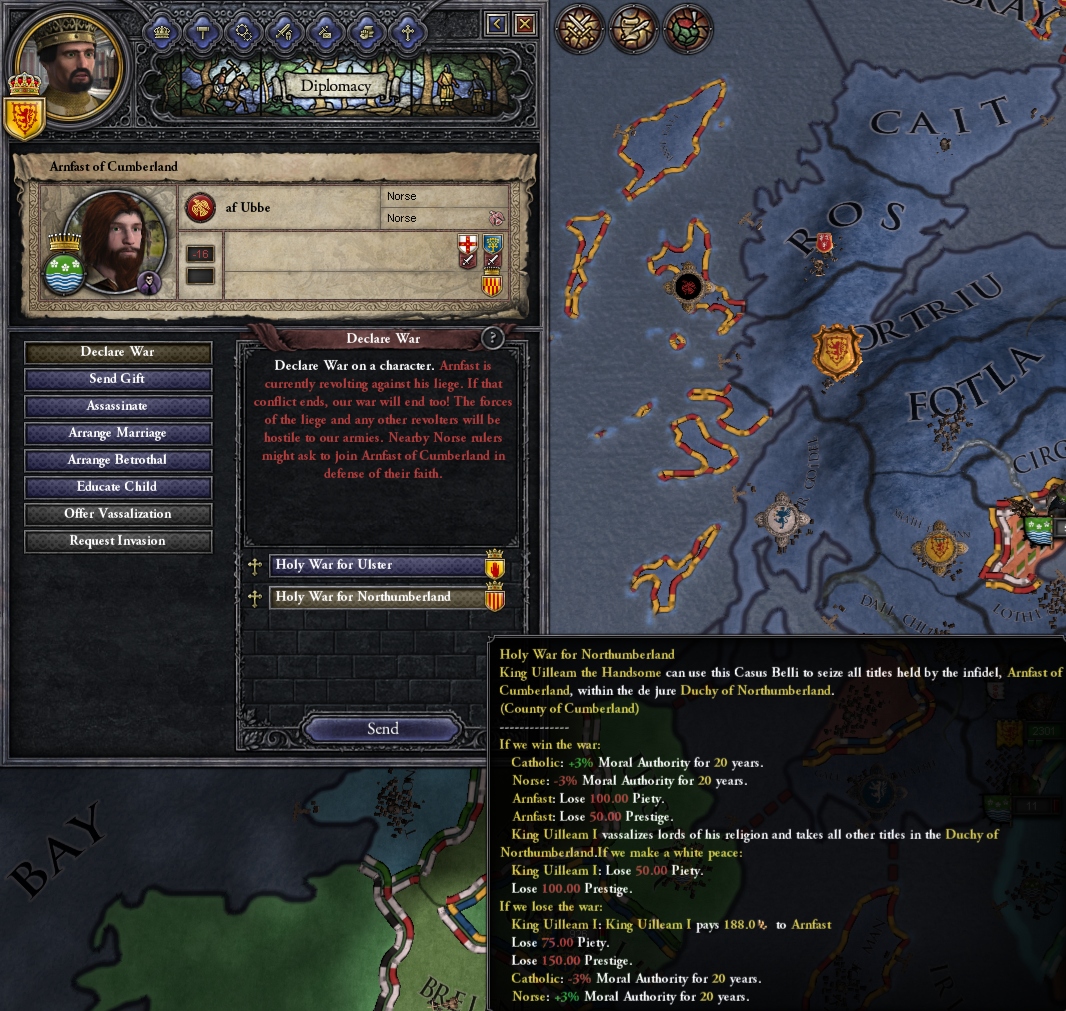
Uilleam’s second son, Mànas, was born in March of 895. There was joy that the dynasty was further secured (if muted due to the child’s dwarven stature).
As Uilleam continued to prosecute the sieges in Cumberland, he began working politics to secure the loyalty and faithfulness of his vassals, with mixed success as factions formed. The greatest benefit to the realm was when the Duke of Munster accept Christianity.
FAU 895.8 Ivar av Ivar, son of Sigtrygg, and Jarl of Munster turned his eyes to the Lord took the Holy Sacrament.

Peasants revolted in Lothian, but they were faced with a raised and ready Scottish force that was fighting nearby in Cumberland. The forces turned north and put the peasant to the sword in January of 896.
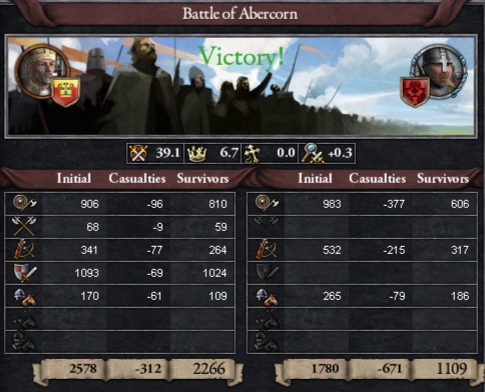
Then in April of the same year, Cumberland was secured and brought into Uilleam’s demesne.
Security
Spymaster and Chaplain were given instruction to bring the av Ivar lords to heel. The role of Chaplain, in particular, would be active bringing the word of god to the av Ivar’s for some time.
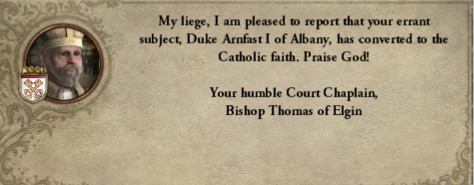
Meanwhile, Uilleam went to find as many ways to make his vassals happy as he could. He started by pressing Duke Ivar of Munster’s claim on Thomond, in Ireland.
FAU 896.11 The battle of Clonmacnoise between the Scotti and Thomond, in which the Scotti won.
After a brief resistance, Thomond was part of Scotland by the end of 897.
Jorvik
Events in to the south in Jorvik would prove pivotal in this period. There had been an uprising against the Norse and their pagan ways. Jorvik and Durham had successfully broken away. However, their victory did not install Catholicism, instead they installed Cathar heresy. This was shocking, but most of the surrounding Christian lords simply chuckled at the plight of King Ragnarr of Jorvik. Uilleam, however, sought advantage. And in June of 898, Jorvik surrendered Fib to Scotland.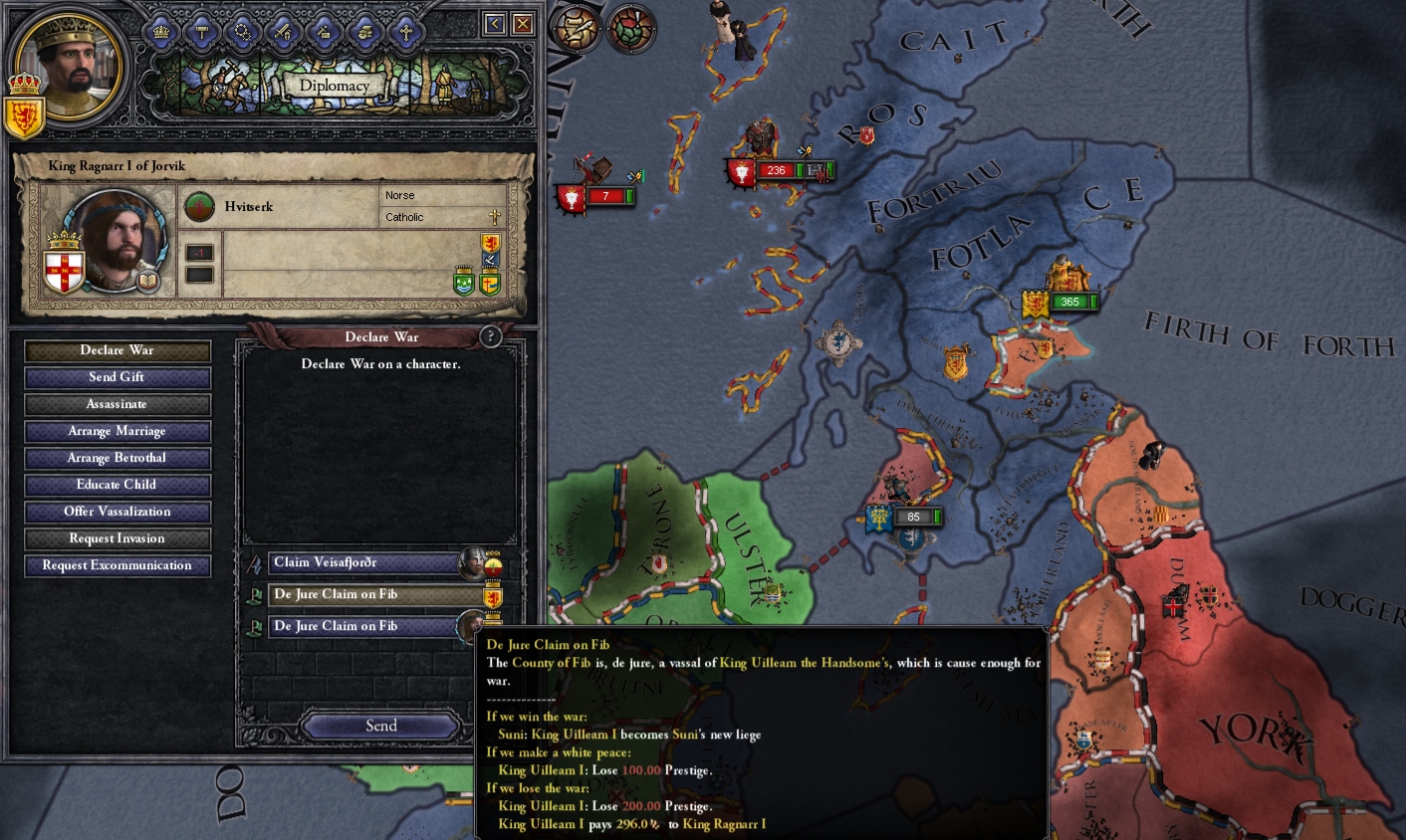
And then Uilleam followed this with a Holy War against the Cathar leaders to take Durham.
Rebellion
It was while the armies of Scotland were subduing Durham that politics and the security of the realm became... complicated. Öysteinn, Count of Dublin, demanded independence for his holding in Ireland, far from Scotland. He managed, somehow, to entice Duke Ivar of Munster to support his faction despite Ivar’s complete happiness with King Uilleam. But Öysteinn was smart enough to take advantage of the support and declared he would fight for his independence.
Uilleam, patiently, continued his war against the Cathars. He did hire the Irish Band of mercenaries, and used them to harass the encroaching rebels, but secured the surrender of Durham in March of 900 before turning his levies west. In the meantime, Dublin’s forces had been supported by opportunists and adventurers, and were proving of some concern.
They finally met in the field in May of 900:
FAU 900.5 The battle of Armagh between the Scotti and rebels. Uilleam, son of Niall, was victor.

This was followed by a defeat for Scotland at Whithorn, however, and the armies continued to jockey for position. It was a victory at Ath Cliath by Scotland (July of 901) that secured the bulk of the fighting and reduced the conflict to sieges, which ended in rebel surrender in January of 903.
Öysteinn was imprisoned, and then had his title revoked. Duke Ivar of Munster was also imprisoned. Ivar lost his title to Teviotdale, and then was ransomed of his freedom. Duke Gorm of Lothian benefited from Uilleam’s generosity and interest in showing goodwill. Gorm had already converted to Catholicism. Teviotdale was in his de jure realm, and as such it was decreed that:
The honor and lands of Teviotdale are estranged from the royal demesne and granted in freehold to Gorm av Ivar, Duke of Lothian, loyal servant of Uilleam mac Niall.
A peasant revolt in December of 904 spoiled what otherwise was a peaceful period in Scotland. The levies were raised, and marched north to the Isles to face the rebels. A victory at Port Rígh and then at Tain saw the problem quickly sorted. The lowborn Alfr, the Norse leader of the revolt was summarily executed.
Jorvik
Jorvik again entered the attention of Scotland. The County of Jorvik and been absorbed back into the Norse holdings of Jylland (though the populace was still Cathar). However, Bagsecg was in revolt against his liege. It seemed the perfect time for a strike, and Uilleam declared a Holy War to capture the territory from the Norse. Largely unopposed, Jorvik fell under Scotland in November of 907.
Domestic Concerns
Again a period of relative peace descended upon the realm. A cathar uprising in Jorvik was put down with little trouble. Ivar of Munster sent his son Ragnarr to be a ward of the King. The celebration of the birth of Ruairidh, the third son of Uilleam in April of 909 was enthusiastically noted. Hemma Karling, Queen of Scotland, inherited the Duchy of Swabia in 900 and was often away, but the boy was left in the Scottish court.
However, it was June of 908 when it is mentioned that Uilleam was afflicted of the Great Pox. The King took interesting action at this point. The Succession Law of the crown of Scotland was shifted to Tanistry. It is believed that a fear of his own mortality drove him to this action, to secure the dynasty and kingdom beyond him.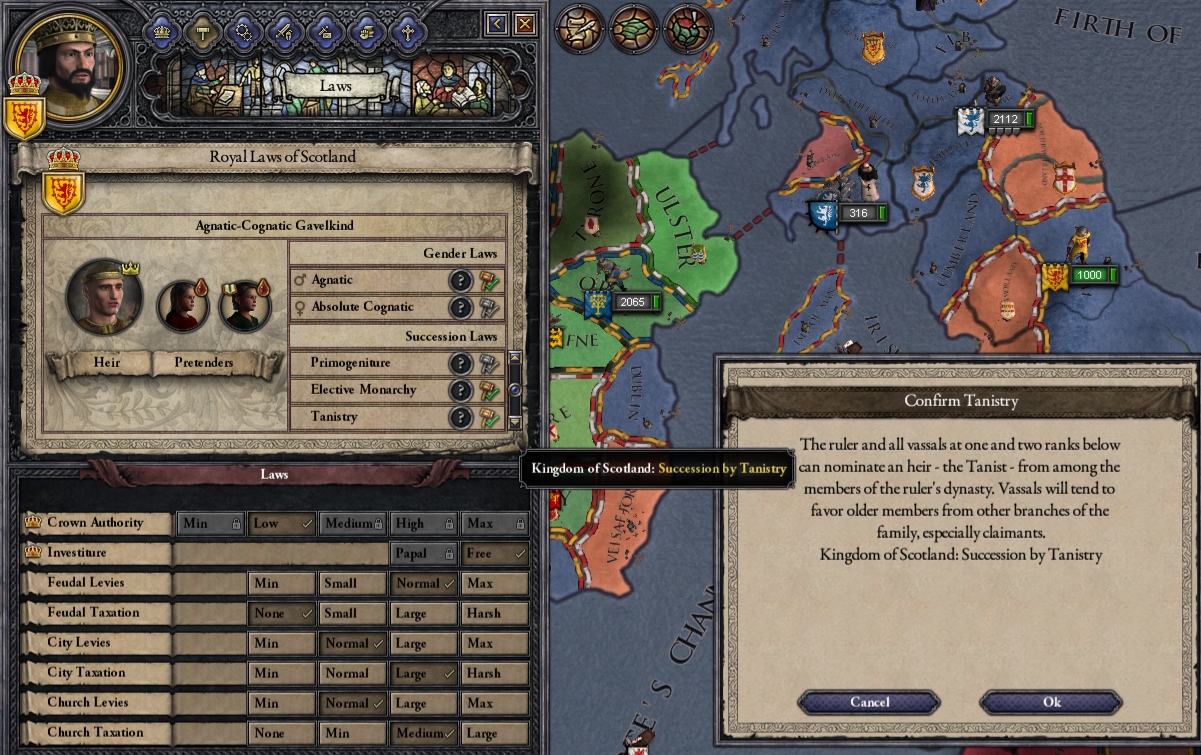
Niall was then named the Tanist. Though this immediately engendered some excitement when Spymaster Ximena - the King’s mother still faithfully serving him - discovered that a lowbown Scottish woman named Morag sought the death of Niall (for reasons that have never been made clear). This was notable for the swift and public action taken, with Morag left to live out her days in the dungeons of Scotland.
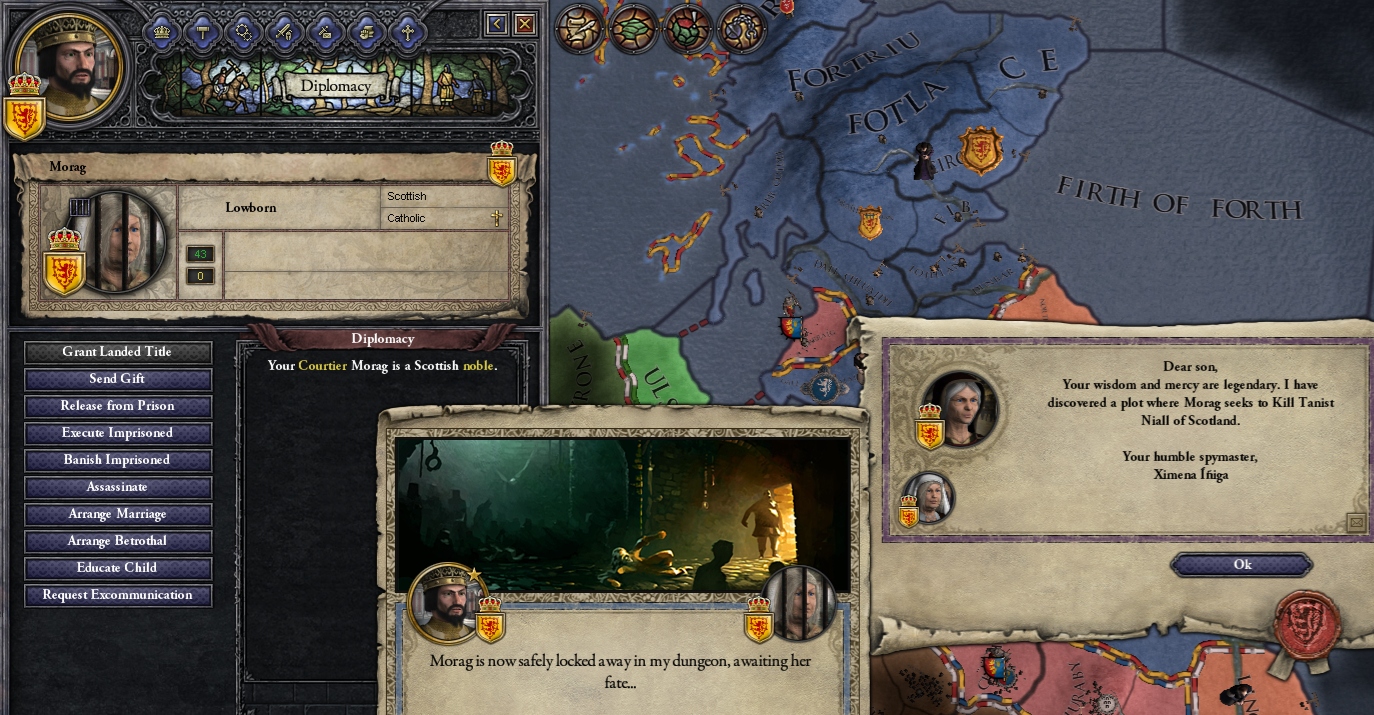
Màiri, the King’s daughter, came of age at the end of 908. The Council was divided on finding a worthy alliance match of marrying her matrilineally to strengthen the dynasty. A search was begun to find her a husband based on either possibility. Meanwhile, Tanist Niall was named Duke of Northumberland, to gain title and prestige for the family. Finally in September of 909 Màiri entered into a normal wedding with Raimbaut I, King of Aquitaine. This offered a second marriage into the House of Karling and an alliance with a meaningful kingdom.
But in 909, Niall passed away. Mànas gained favor as the Tanist, despite his dwarven stature. The only other options were younger than he. The King resolved to raise his other children to be worthy and try and sort out the succession as soon as prudent.
Jorvik
King Ragnarr of Jorvik had passed, and his daughter Björg was Queen. Uilleam had gathered claims to lands in Lancaster and felt that in October of 909 it was time to pursue them. War was declared. As the levies mustered, the political situation became more complicated. Jorvik had a strong alliance by family with Gwynedd, and that Welsh kingdom with considerable strength rallied to the defense of Jorvik. Scotland prepared for a fight, and the Council agreed that more attention need to go into taking lands from Jorvik/Gwynedd before they became a serious threat in Britain.

But action in prosecuting the war was interrupted:
FAU 909.12 Uilleam mac Niall, 'The Handsome', fell asleep in the Lord.
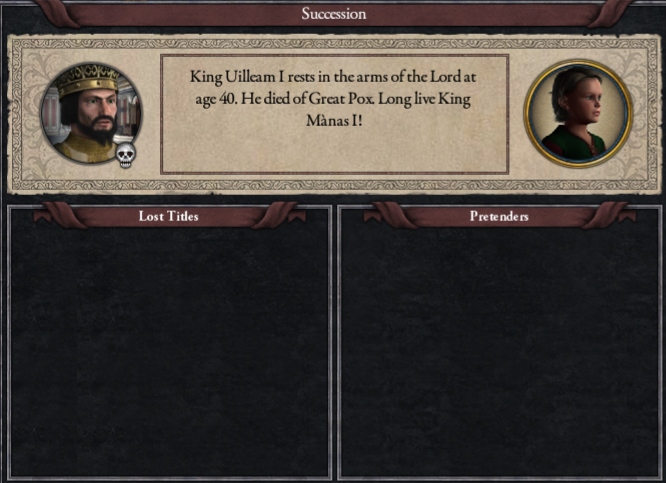
No comments:
Post a Comment